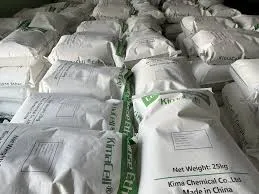
Oct . 06, 2024 04:45 Back to list
hydroxyalkyl cellulose
Hydroxyalkyl Cellulose Versatile Functional Agents in Various Industries
Hydroxyalkyl cellulose (HAC) refers to a range of cellulose derivatives characterized by hydroxyalkyl substitutions. These modifications enhance the natural properties of cellulose, leading to various functionalities that make hydroxyalkyl cellulose an invaluable ingredient in numerous applications ranging from pharmaceuticals to food products and industrial formulations.
Properties and Characteristics
Hydroxyalkyl cellulose is produced by reacting natural cellulose with alkaline conditions and hydroxyalkylating agents, such as ethylene oxide or propylene oxide. The extent of substitution, determined by the degree of hydroxyalkylation, plays a critical role in the properties of the resulting cellulose derivative. Different types of hydroxyalkyl cellulose, such as hydroxyethyl cellulose (HEC) and hydroxypropyl cellulose (HPC), exhibit unique properties catering to specific applications.
One of the most attractive features of hydroxyalkyl cellulose is its solubility in water. This property serves important functions in formulations where a thickening agent or stabilizer is required. Additionally, the viscosity of hydroxyalkyl cellulose solutions can be manipulated by adjusting concentrations, making it suitable for use in both low- and high-viscosity products.
Applications in Pharmaceuticals
In the pharmaceutical industry, hydroxyalkyl cellulose is widely utilized as a thickener, binder, and film-forming agent. Its ability to form gels and control the release of active ingredients makes it a preferred option in drug formulations. Furthermore, it is often used in topical preparations due to its excellent compatibility with skin and mucous membranes. Hydroxyethyl cellulose, for example, is commonly found in ophthalmic solutions and hydrogels due to its hydrophilic nature, which aids in ocular retention and enhances comfort for the user.
Use in Personal Care Products
Hydroxyalkyl cellulose is also prevalent in the cosmetics and personal care sector. It is extensively used in lotions, creams, shampoos, and other formulations to improve texture, stability, and performance. Its emulsifying properties enhance the consistency of emulsions, while its film-forming ability can create a protective layer on the skin or hair, contributing to product efficacy. Moreover, as a thickening agent, it helps in achieving the desired viscosity in personal care products without adversely impacting skin feel.
hydroxyalkyl cellulose

Role in Food Industry
In the food sector, hydroxyalkyl cellulose serves as a food additive, often used as a thickener, stabilizer, or emulsifier. It can enhance the mouthfeel and texture of various food products, including sauces, dressings, and baked goods. Additionally, hydroxyalkyl cellulose is appreciated for its ability to retain moisture in food products, therefore extending their shelf life.
Industrial Applications
Beyond consumer-facing products, hydroxyalkyl cellulose finds utility in industrial applications such as paints, coatings, and adhesives. Its rheological properties allow for improved flow and stability in formulations, while also contributing to the film-forming characteristics essential in coatings. In construction, hydroxyalkyl cellulose is employed in cement-based formulations and tile adhesives, promoting workability and adhesion properties.
Environmental Considerations
As a derivative of cellulose, hydroxyalkyl cellulose is derived from renewable resources, aligning with the growing demand for sustainable and eco-friendly materials. Furthermore, its biodegradability and low toxicity make it a safer alternative for many applications compared to synthetic polymers.
Conclusion
Hydroxyalkyl cellulose is a multifunctional agent that plays a vital role across various industries, thanks to its unique properties and versatility. As research continues to explore its capabilities, hydroxyalkyl cellulose is bound to find even more innovative applications in the future, reinforcing its significance in modern formulations and sustainable practices.
-
Versatile Hpmc Uses in Different Industries
NewsJun.19,2025
-
Redispersible Powder's Role in Enhancing Durability of Construction Products
NewsJun.19,2025
-
Hydroxyethyl Cellulose Applications Driving Green Industrial Processes
NewsJun.19,2025
-
Exploring Different Redispersible Polymer Powder
NewsJun.19,2025
-
Choosing the Right Mortar Bonding Agent
NewsJun.19,2025
-
Applications and Significance of China Hpmc in Modern Industries
NewsJun.19,2025







